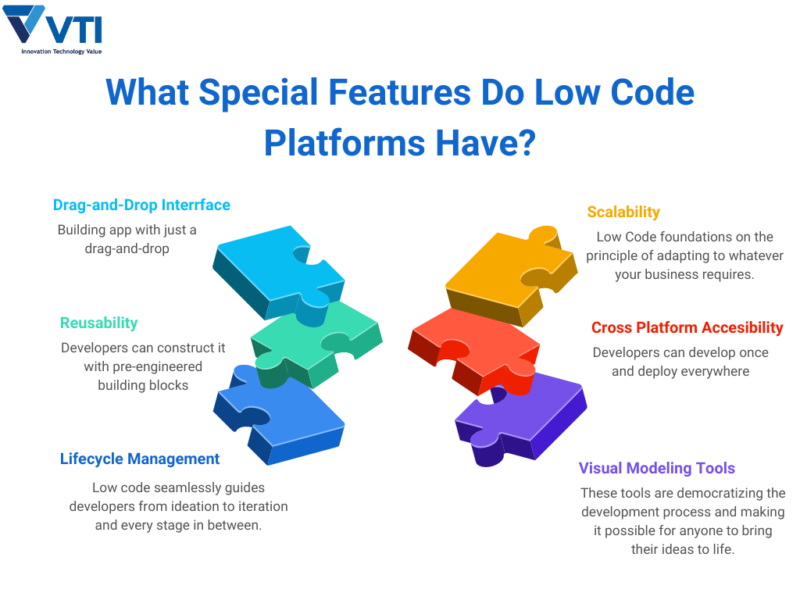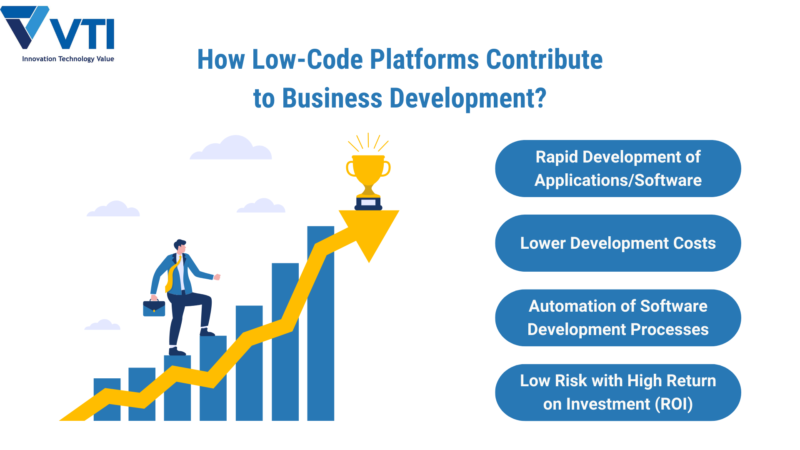“By 2024, the development of low-code applications is predicted to account for more than 65% of application development activities.”
That is Gartner’s forecast for the future of low-code platforms. Furthermore, the global market value of low-code platforms is expected to reach $65.15 billion by 2027, with a Compound Annual Growth Rate (CAGR) of 22.7% during the period from 2020 to 2027.
So, what exactly are low-code platforms, and what prospects do they bring that capture the interest of businesses? Let’s explore this anticipated game-changer for software development through this blog with VTI.
The Emergence of Low-Code Platforms
The digital transformation wave has hit businesses across industries, compelling them to adopt and integrate innovative technologies. This surge in demand for software solutions, ranging from mobile apps to complex enterprise systems. As businesses strive to stay competitive, the need for faster and cost-effective software development solutions becomes paramount.
The traditional approach to software development requires a significant investment in hiring and retaining skilled programmers. However, with the increasing demand, the available talent pool falls short, leading to delays in project timelines and increased development costs.
And from these emerging needs, low-code platforms have risen as a promising solution for businesses. In simple terms, low-code is an application development approach through a visual interface, following conventional logic to quickly create and develop applications. These innovative solutions allow users with varying levels of technical expertise to build applications with minimal coding effort. Low-code platforms provide a visual interface, enabling users to drag-and-drop components.
What Special Features Do Low-Code Platforms Have?

- Drag-and-Drop Interface
Imagine building your dream app by assembling legos, and snapping together pre-built components like buttons, forms, and databases with just a drag-and-drop. Low-code platforms are designed to accommodate individuals ranging from citizen developers to skilled developers. It empowers businesses to construct internal tools, automate workflows, and develop robust customer-facing applications, all achieved without the necessity of writing a single line of code.
- Reusability
Instead of building each app from the beginning, developers construct it with pre-engineered building blocks. These blocks which are pre-configured modules, logic, templates, connectors, etc., are the foundation of a reusable ecosystem. While reusability saves time, it doesn’t sacrifice customization. Skilled developers can extend and modify pre-built components to meet specific needs.
- Lifecycle Management
Building an app is just one piece of the puzzle. What happens after the “Launch” button is pressed? This is precisely where lifecycle management steps in, and low-code platforms are reshaping the entire dynamic. No longer are developers confronted with an app and a stack of sticky notes to navigate its progression. Low-code seamlessly guides developers through the entire journey, from ideation to iteration and every stage in between.
- Scalability
Speed, reusability, and lifecycle management are impressive, but when it comes to long-term success, one feature reigns supreme: scalability. Low-code platforms understand this, and they’ve built their foundations on the principle of adapting to whatever your business throws at it. Whether your user base explodes from twenty to two hundred or your data demands multiply overnight, a good low-code platform has your back.
- Cross Platform Accesibility
Low-code platforms go beyond just building across platforms, It ensures your apps are accessible to everyone on every device. Developers can develop once and deploy everywhere, reaching a wider audience with consistent, platform-specific experiences. Responsive design tools adapt the app to any screen, while native rendering engines make it feel like it belongs on each device.
- Visual Modeling Tools
Low-code platforms are democratizing software development and visual modeling tools are the key that unlocks the door for everyone, from non-technical users to skilled developers. With their intuitive interfaces, clear representations, and flexibility, these tools are democratizing the development process and making it possible for anyone to bring their ideas to life.
How Low-Code Platforms Contribute to Business Development?

- Rapid Development of Applications/Software
According to Forrester, low-code has the potential to accelerate application development up to 10 times, meaning that developers can ideate, build, test, and deploy new applications within days or weeks instead of months. With this quick development cycle, companies may keep ahead of the competition, quickly adapt to market demands, and quickly take advantage of new opportunities.
- Lower Development Costs
Traditional software development often comes with high costs, primarily due to the need for a skilled and specialized workforce. Low-code platforms, however, democratize development by allowing individuals with varying levels of technical expertise to contribute. Businesses can reallocate resources to innovation and strategic initiatives rather than being burdened by exorbitant development expenses.
- Automation of Software Development Processes
Low-code platforms bring automation to the forefront of software development processes. By providing pre-built components, templates, and integrations, these platforms automate repetitive tasks, allowing developers to focus on more complex and strategic aspects of application development.
- Low Risk with High Return on Investment (ROI)
One of the significant advantages of low-code development is the inherent reduction of risk. Additionally, the faster development cycles and lower costs contribute to a higher return on investment. A report by IDC reveals that customers have achieved a 509% return on investment (ROI) after 5 years of utilizing low-code and intelligent process automation. Furthermore, 100% of businesses utilizing low-code platforms have reported earning ROI from their respective platforms.
Does Low-Code Mean “Anyone Can Code” Without Any Prior Knowledge about Coding?

If one only looks at the features and potential of low-code, many might mistakenly believe that anyone can code with low-code, even without any knowledge of coding. However, low-code is not about “anyone can code” but rather focuses on reducing the complexity of the application development process by minimizing manual coding.
The goal of low-code is to make the application development process more visual and accessible to a broader audience, from skilled developers to citizen developers with little programming experience. Visual interfaces, reusable components, and supportive tools are the key elements of low-code, aiding in accelerating the development process. Therefore, a basic understanding of programming logic and business processes is still necessary to fully harness the potential of low-code.
Trends and Predictions of Low-Code Platforms in 2024
- Continued Growth and Adoption
Companies from diverse sectors are catching on to the advantages of using low-code solutions for fast and effective app development. If such a shift keeps its speed, almost three-quarters of all new business apps will be built using this technology by 2025. And by 2024, 80% of people who are non-IT professionals will be creating IT products and services, and the majority will be applying low-code tools to do it.
- AI and Automation Integration
In 2024, prepare to see the blending of low-code platforms and AI technologies. Now, thanks to user-friendly APIs, AI isn’t just for the tech gurus anymore, it’s becoming accessible to people from all kinds of backgrounds. Low-code platforms serve as a go-between, making it easier to apply AI features to business applications. Using AI in this way allows developers to whip up smart apps that can do things like automate routine jobs. base actions on data analysis, and tailor the user experience.
- Development of Citizen Developers
By 2024, citizen developers are expected to contribute to the creation of 80% of technology products and services. Democratization of development opens up the software development process to citizen developers to reach a larger audience than professional developers. Currently, 41% of organizations have ongoing citizen development initiatives, while 20% of those without such programs are either evaluating or in the planning stages for launching citizen development programs.
- Low-Code Platforms in Digital Transformation
84% of enterprise businesses have adopted low-code platforms to reduce the tension of IT teams. They also see low-code as a promising investment to accelerate digital transformation. Low-code isn’t limited to simple applications since 41% of developers express a desire for more applications built on low-code platforms.
Low-Code – The Future of Software Development
Gartner’s predictions say that “by the year 2025, organizations will build 70% of new applications using low-code or no-code platforms.”
The emergence of low-code platforms is also the foundation for democratizing software development during the digital transformation era. The provided statistics serve as clear evidence for this statement.
VTI hopes that this blog will help everyone gain a clearer understanding of the low-code platform and its potential for the future. If you are considering deploying low-code platforms but unsure where to start, feel free to contact VTI, we are always ready to accompany clients throughout the entire low-code implementation process, from consultation and development to testing, maintenance, and operation.
![[FREE EBOOK] Strategic Vietnam IT Outsourcing: Optimizing Cost and Workforce Efficiency](https://vti.com.vn/wp-content/uploads/2023/08/cover-mockup_ebook-it-outsourcing-20230331111004-ynxdn-1.png)




